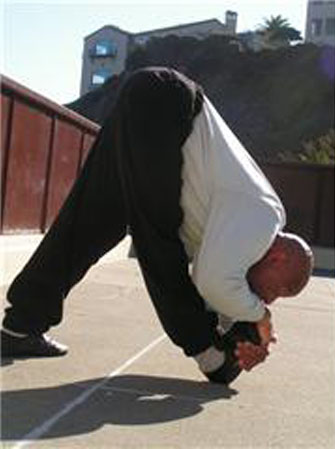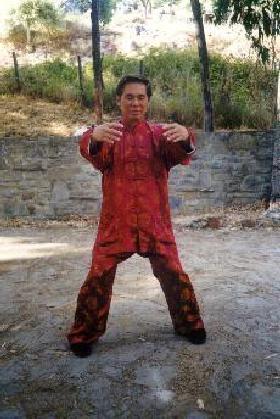Spring is here, and many of us are beating cabin fever by getting out and in the garden. Our often over zealous nature leads to early mornings rushing out and pulling weeds, removing debris, and tilling the ground. Then, before we know it, we’re doing the “stiff duck walk” from tight muscles in the back, hips, legs, and, well, everywhere. While cursing old age and winter are more than permissible, it’s definitely time for some good stretches to keep those muscles, tendons, and ligaments loosened. Here are some ideas from the world of martial arts to help you stay flexible through the whole season.
Kung fu flex
Frederick Chu, an acolyte in the martial arts with 7+ years under his belt and medical school student at University of Illinois College of Medicine, gives us three stances to develop hip, leg, and back muscles. These stances, when done properly, will help you develop strength in your limbs. And we all know, strength can help you feel great about yourself, lift those heavy bags of soil, move pots like they are nothing, and help you last longer in the garden without pain. He recommends using horse stance, three circle stance, and the picturesquely named “monk takes off shoe” to gain strength and flexibility.
Horse Stance
 Horse stance is a very fundamental stance to martial arts. It is similar to the squat stance in modern weight lifting, but with a wider base for stability during fighting. In terms of flexibility you’ll feel it in the inner hips and groin area, but you’ll feel a great deal of strength being built everywhere in the lower body.
Horse stance is a very fundamental stance to martial arts. It is similar to the squat stance in modern weight lifting, but with a wider base for stability during fighting. In terms of flexibility you’ll feel it in the inner hips and groin area, but you’ll feel a great deal of strength being built everywhere in the lower body.
To do the horse stance properly, start with your feet together directly in line with your upper body.
- Turn your toes out.
- Turn your heels out.
- Turn your toes out again.
- Turn your heels out again.
- Check your alignment and posture. Your feel should be relaxed, your weight centred like the diagram to the right — even if your feet aren’t as far out. People with knee problems should stop here so you don’t turn your knees out of alignment.
- If you are practising for self defence as well, repeat turning your toes and heels out one more time to get a deeper horse stance.
A word of caution about the stance. The image you see to the right is for self defence. A deeper squat has more stability in combat training since it would be harder to push you over. However, a shallower squat will still allow you to reap the benefits of this wonderful posture.
Three Circle Stance
Once you have the hang of the horse stance, it’s time to add a little bit of movement on the upper body. This will help you gain strength in the lower body while loosening up the upper body. Move yourself into horse stance, then simply raise the arms to a large circle in front of you — like you are hugging a tree. Make sure you are relaxed! This is no time for building up tensions.
Breathe deeply and focus on your breath moving in and out of your body for 5 breaths. Lower your arms, stand up, and shake it out. Repeat a few times paying particular attention to posture, breathing, and maintaining a relaxed feeling throughout your body — that includes the legs. Trust me, it’s easier to hold it that way.
One more thing: Notice how in this image the practitioner is holding a more shallow version of the horse stance compared to that above. I, personally, found that this is easier on the knees for those of us dealing with injuries. It’s also much easier for beginners as it puts less strain on the knees and thigh muscles from over doing it or having improper posture. If you’re not used to kung fu, I highly recommend copying this example for how far out to move your legs.
Old Monk Removes Shoe
Besides having an utterly hilarious name, this move is something of a familiar touch to Fred’s recommendations. Whether you haven’t done these sorts of moves since you were a kid or aspire to the perfect yoga toe touch stretch, this one will have you simultaneously smirking and shaking your head with a firm “no”. Don’t worry, though, as we’re not crazy. You can do this — even if you have to work in small increments.
If you do a search for “chin to toe stretch”, you’ll see that this pose can be done on the ground, not balancing like the image to the right. After all, us normal people would likely totter and fall over long before we reached the toes, let alone before we got our chin to touch the toes. This is good news as it means you can do this on the comfort and safety of your floor while you stretch. So, clear a spot among your pots and soil, grab a rope, and let’s get stretching. This pose is, after all, going to help you loosen all those stiff muscles from the calves up to the upper back — if you do it right.
Start by sitting on the ground, legs straight out in front of you.
- Sit up tall, then reach your arms up above your head. Breathe in
- Then, as you breath out reach up and out over your legs towards your toes. Reach as far as you can. If you’re anything like me, you can get to your shins, some days your ankles, and you feel like all the world is at your feet if you can get to your toes easily. This is where the rope, towel, or belt comes in. Use it to loop around your foot and help you develop into the stretch more if you need it.
- Stay here and relax into the pose. With every breathe, allow yourself to relax just a little more and reach a little further.
- Return to sitting upright after a few breaths.
- Repeat as desired.
This is very similar to the forward seated bend in yoga, but the primary difference is that when you can reach the toes, you should try to bring your toes to the chin. This gives a deeper stretch in the calf, which we gardeners use a lot in squatting, as well as the hips, legs, and hamstrings.
If you find you can do it sitting down, test your balance and try it standing! Just try on a softer surface in case you fall.
Kung fu isn’t often thought of as a way to stay healthy and fit for other activities, but I find it as a more interesting and unique way to challenge the body and ready it for the garden work. What do you think after giving just these three a try?


